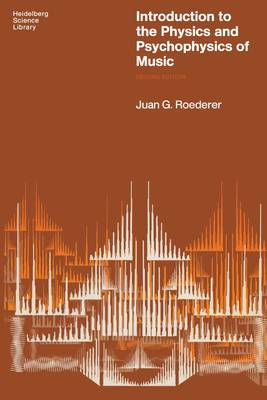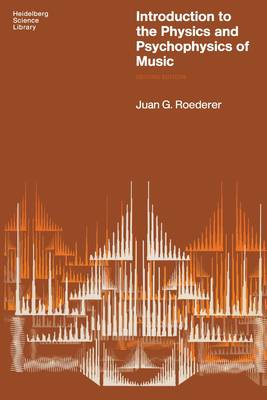
- Afhalen na 1 uur in een winkel met voorraad
- Gratis thuislevering in België vanaf € 30
- Ruim aanbod met 7 miljoen producten
- Afhalen na 1 uur in een winkel met voorraad
- Gratis thuislevering in België vanaf € 30
- Ruim aanbod met 7 miljoen producten
Zoeken
€ 83,95
+ 167 punten
Omschrijving
1 Music, Physics, and Psychophysics: An Interdisciplinary Approach.- 1.1 The intervening physical systems 1 / 1.2 Characteristic attributes of musical sounds 3 / 1.3 The time element in music 5 / 1.4 Physics and psychophysics 7 / 1.5 What is music? 11.- 2 Sound Vibrations, Pure Tones, and the Perception of Pitch.- 2.1 Motion and vibration 13 / 2.2 Simple harmonic motion 17 / 2.3 Acoustical vibrations and pure tone sensations 18 / 2.4 Superposition of pure tones: first-order beats and the critical band 25 / 2.5 Other first-order effects: combination tones and aural harmonics 33 / 2.6 Second-order effects: beats of mistuned consonances 37 / 2.7 Fundamental tracking 40 / 2.8 Auditory coding in the peripheral nervous system 44 / 2.9 Periodicity pitch and the role of the central nervous system 50.- 3 Sound Waves, Acoustical Energy, and the Perception of Loudness.- 3.1 Elastic waves, force, energy, and power 61 / 3.2 Propagation speed, wavelength, and acoustical power 65 / 3.3 Superposition of waves; standing waves 74 / 3.4 Intensity, sound intensity level, and loudness 78 / 3.5 The loudness perception mechanism and related processes 89.- 4 Generation of Musical Sounds, Complex Tones, and the Perception of Tone Quality.- 4.1 Standing waves in a string 93 / 4.2 Generation of complex standing vibrations in string instruments 98 / 4.3 Sound vibration spectra and resonance 106 / 4.4 Standing longitudinal waves in an idealized air column 115 / 4.5 Generation of complex standing vibrations in wind instruments 119 / 4.6 Sound spectra of wind instrument tones 126 / 4.7 Trapping and absorption of sound waves in a closed environment 128 / 4.8 Perception of pitch and timbre of musical tones 133 / 4.9 Identification of musical sounds 138.- 5 Superposition and Successions of Complex Tones and the Perception of Music.- 5.1 Superposition of complex tones 143 / 5.2 The sensation of musical consonance and dissonance 146 / 5.3 Building musical scales 153 / 5.4 The standard scale and the standard of pitch 158 / 5.5 Why are there musical scales and why do we experience musical sensations? 161 / 5.6 Specialization of speech and music processing in the cerebral hemispheres 165.- Appendix I Some Quantitative Aspects of the Bowing Mechanism.- Appendix II Some Quantitative Aspects of Recent Central Pitch Processor Models.- Appendix III Some Remarks on Teaching Physics and Psychophysics of Music.- References.
Specificaties
Betrokkenen
- Auteur(s):
- Uitgeverij:
Inhoud
- Aantal bladzijden:
- 216
- Taal:
- Engels
Eigenschappen
- Productcode (EAN):
- 9781461599838
- Verschijningsdatum:
- 21/01/2012
- Uitvoering:
- Paperback
- Formaat:
- Trade paperback (VS)
- Afmetingen:
- 156 mm x 234 mm
- Gewicht:
- 308 g

Alleen bij Standaard Boekhandel
+ 167 punten op je klantenkaart van Standaard Boekhandel
Beoordelingen
We publiceren alleen reviews die voldoen aan de voorwaarden voor reviews. Bekijk onze voorwaarden voor reviews.








